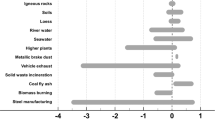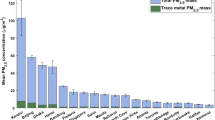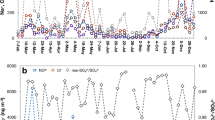Abstract
Inorganic and organic arsenic compounds in nature are methylated by biological action and released into the air, forming trimethylar-sine and dimethylarsine1–5. These compounds are oxidized in the air to dimethylarsinic acid and trimethylarsineoxide6 and exist as particles7,8. In this study, we examine seasonal variations of methylarsenic compounds in airborne particulate matter to try to understand the characteristics of the methylation of arsenic in nature. In summer a high concentration of dimethyl and trimethyl forms of arsenic was observed, while in winter the levels were very low. This seasonal variation can be attributed to the different temperatures of the environment during these seasons. The activation energy of methylation of arsenic was estimated to be ∼12 kcal mol−1 from Arrhenius plots and can be used to predict the behaviour of these methylarsenic compounds, which are considered to form an important portion of the arsenic present in airborne particulate matter.
This is a preview of subscription content, access via your institution
Access options
Subscribe to this journal
Receive 51 print issues and online access
$199.00 per year
only $3.90 per issue
Buy this article
- Purchase on Springer Link
- Instant access to full article PDF
Prices may be subject to local taxes which are calculated during checkout
Similar content being viewed by others
References
Challenger, F., Higginbottom, C. & Eillis, L. J. chem. Soc. 95–101 (1933).
Challenger, F. & Higginbottom, C. Biochem. J. 29, 1757–1788 (1935).
McBride, B. C. & Wolfe, R. S. Biochemistry 10, 4312–4317 (1971).
Cox, D. P. & Alexander, M. Bull. Envir. Contam. Toxicol. 9, 84–88 (1973).
Wood, J. M. Science 183, 1049–1052 (1974).
Parris, G. E. & Brinckman, F. E. Envir. Sci. Technol. 10, 1128–1134 (1976).
Johnson, D. L. & Braman, R. S. Chemosphere 4, 333–338 (1975).
Tanaka, S., Kaneko, M. & Hashimoto, Y. J. chem. Soc. Jap. 637–642 (1984).
Braman, R. S. & Foreback, C. C. Science 182, 1247–1249 (1973).
Andreae, M. O. Limnol Oceanogr. 24, 440–452 (1979).
Akins, M. B. & Lewis, R. J. Soil Sci. Soc. Am. J. 40, 655–658 (1976).
Braman, R. S., Johnson, D. L., Foreback, C. C., Ammons, J. M. & Bricker, J. L. Analyt. Chem. 49, 621–625 (1977).
Mukai, H. & Ambe, Y. Analyt. chim. Acta. (submitted).
Mukai, H. & Ambe, Y. Atmos. Envir. (in the press).
Chau, Y. K., Wong, P. T. S., Silverberg, B. A., Luxon, P. L. & Bengert, G. A. Science 192, 1130–1131 (1976).
Woolson, E. A. Envir. Hlth Perspect. 19, 73–81 (1977).
Author information
Authors and Affiliations
Rights and permissions
About this article
Cite this article
Mukai, H., Ambe, Y., Muku, T. et al. Seasonal variation of methylarsenic compounds in airborne participate matter. Nature 324, 239–241 (1986). https://doi.org/10.1038/324239a0
Received:
Accepted:
Issue Date:
DOI: https://doi.org/10.1038/324239a0
This article is cited by
-
A global survey of arsenic-related genes in soil microbiomes
BMC Biology (2019)
-
Impact of Microorganisms on Arsenic Biogeochemistry: A Review
Water, Air, & Soil Pollution (2014)
-
Organic Arsenic in the Soil Environment: Speciation, Occurrence, Transformation, and Adsorption Behavior
Water, Air, & Soil Pollution (2011)
-
Demethylation of Dimethylarsinic Acid and Arsenobetaine in Different Organic Soils
Water, Air, and Soil Pollution (2007)
-
Volatilization of tin as stannane in anoxic environments
Nature (1988)
Comments
By submitting a comment you agree to abide by our Terms and Community Guidelines. If you find something abusive or that does not comply with our terms or guidelines please flag it as inappropriate.



